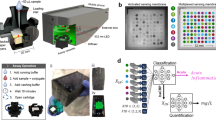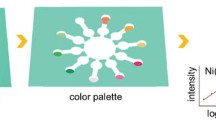Abstract
Microfluidic paper-based analytical devices (μPADs) have been widely used in point-of-care testing owing to their simple operation, low volume of the sample required, and the lack of the need for an external force. To obtain accurate semi-quantitative or quantitative results, μPADs need to respond to the challenges posed by differences in reaction conditions. In this paper, multi-layer μPADs are fabricated by the imprinting method for the colorimetric detection of C-reactive protein (CRP). Different lighting conditions and shooting angles of scenes are simulated in image acquisition, and the detection-related performance of μPADs is improved by using a machine learning algorithm. The You Only Look Once (YOLO) model is used to identify the areas of reaction in μPADs. This model can observe an image only once to predict the objects present in it and their locations. The YOLO model trained in this study was able to identify all the reaction areas quickly without incurring any error. These reaction areas were categorized by classification algorithms to determine the risk level of CRP concentration. Multi-layer perceptron, convolutional neural network, and residual network algorithms were used for the classification tasks, where the latter yielded the highest accuracy of 96%. It has a promising application prospect in fast recognition and analysis of μPADs.
Graphical abstract







Similar content being viewed by others
References
Yang JC, Wang K, Xu H, Yan WQ, Jin QH, Cui DX. Detection platforms for point-of-care testing based on colorimetric, luminescent and magnetic assays: a review. Talanta. 2019;202:96–110. https://doi.org/10.1016/j.talanta.2019.04.054.
Das B, Franco JL, Logan N, Balasubramanian P, Kim MI, Cao C. Nanozymes in point-of-care diagnosis: an emerging futuristic approach for biosensing. Nano-Micro Lett. 2021;13(1):51. https://doi.org/10.1007/s40820-021-00717-0.
Cheng YM, Wang K, Xu H, Li TA, Jin QH, Cui DX. Recent developments in sensors for wearable device applications. Anal Bioanal Chem. 2021;413(24):6037–57. https://doi.org/10.1007/s00216-021-03602-2.
Zheng W, Wang K, Xu H, Zheng CJ, Cao B, Qin Q, et al. Strategies for the detection of target analytes using microfluidic paper-based analytical devices. Anal Bioanal Chem. 2021;413(9):2429–45. https://doi.org/10.1007/s00216-021-03213-x.
Martinez AW, Phillips ST, Butte MJ, Whitesides GM. Patterned paper as a platform for inexpensive, low-volume, portable bioassays. Angew Chem-Int Edit. 2007;46(8):1318–20. https://doi.org/10.1002/anie.200603817.
Trofimchuk E, Hu YX, Nilghaz A, Hua MZ, Sun SLN, Lu XN. Development of paper-based microfluidic device for the determination of nitrite in meat. Food Chem. 2020;316:6. https://doi.org/10.1016/j.foodchem.2020.126396.
Fakhri N, Hosseini M, Tavakoli O. Aptamer-based colorimetric determination of Pb2+ using a paper-based microfluidic platform. Anal Methods. 2018;10(36):4438–44. https://doi.org/10.1039/c8ay01331d.
Liu CY, Miao YQ, Zhan XJ, Zhang SL, Zhao XJ. Colorimetric determination of cysteine by a paper-based assay system using aspartic acid modified gold nanoparticles. Microchim Acta. 2020;187(6):8. https://doi.org/10.1007/s00604-020-04333-4.
Wang K, Yang JC, Xu H, Cao B, Qin Q, Liao XM, et al. Smartphone-imaged multilayered paper-based analytical device for colorimetric analysis of carcinoembryonic antigen. Anal Bioanal Chem. 2020;412(11):2517–28. https://doi.org/10.1007/s00216-020-02475-1.
Shibata H, Hiruta Y, Citterio D. Fully inkjet-printed distance-based paper microfluidic devices for colorimetric calcium determination using ion-selective optodes. Analyst. 2019;144(4):1178–86. https://doi.org/10.1039/c8an02146e.
Adkins J, Boehle K, Henry C. Electrochemical paper-based microfluidic devices. Electrophoresis. 2015;36(16):1811–24. https://doi.org/10.1002/elps.201500084.
Ming T, Wang Y, Luo JP, Liu JT, Sun S, Xing Y, et al. Folding paper-based aptasensor platform coated with novel nanoassemblies for instant and highly sensitive detection of 17 beta-estradiol. ACS Sens. 2019;4(12):3186-+. https://doi.org/10.1021/acssensors.9b01633.
Wang Y, Luo JP, Liu JT, Sun S, Xiong Y, Ma YY, et al. Label-free microfluidic paper-based electrochemical aptasensor for ultrasensitive and simultaneous multiplexed detection of cancer biomarkers. Biosens Bioelectron. 2019;136:84–90. https://doi.org/10.1016/j.bios.2019.04.032.
Cao QP, Liang B, Tu TT, Wei JW, Fang L, Ye XS. Three-dimensional paper-based microfluidic electrochemical integrated devices (3D-PMED) for wearable electrochemical glucose detection. RSC Adv. 2019;9(10):5674–81. https://doi.org/10.1039/c8ra09157a.
Alahmad W, Uraisin K, Nacapricha D, Kaneta T. A miniaturized chemiluminescence detection system for a microfluidic paper-based analytical device and its application to the determination of chromium(III). Anal Methods. 2016;8(27):5414–20. https://doi.org/10.1039/c6ay00954a.
Hassanzadeh J, Al Lawati HAJ, Al LI. Metal-organic framework loaded by rhodamine B as a novel chemiluminescence system for the paper-based analytical devices and its application for total phenolic content determination in food samples. Anal Chem. 2019;91(16):10631–9. https://doi.org/10.1021/acs.analchem.9b01862.
Liu FF, Zhang CS. A novel paper-based microfluidic enhanced chemiluminescence biosensor for facile, reliable and highly-sensitive gene detection of Listeria monocytogenes. Sens Actuator B-Chem. 2015;209:399–406. https://doi.org/10.1016/j.snb.2014.11.099.
Chen Y, Chu WR, Liu W, Guo XY, Jin Y, Li BX. Paper-based chemiluminescence immunodevice for the carcinoembryonic antigen by employing multi-enzyme carbon nanosphere signal enhancement. Microchim Acta. 2018;185(3):7. https://doi.org/10.1007/s00604-018-2726-5.
Sun XE, Li BW, Tian CY, Yu FB, Zhou N, Zhan YH, et al. Rotational paper-based electrochemiluminescence immunodevices for sensitive and multiplexed detection of cancer biomarkers. Anal Chim Acta. 2018;1007:33–9. https://doi.org/10.1016/j.aca.2017.12.005.
Li L, Zhang Y, Liu F, Su M, Liang LL, Ge SG, et al. Real-time visual determination of the flux of hydrogen sulphide using a hollow-channel paper electrode. Chem Commun. 2015;51(74):14030–3. https://doi.org/10.1039/c5cc05710h.
Wu LD, Ma C, Zheng XX, Liu HY, Yu JH. Paper-based electrochemiluminescence origami device for protein detection using assembled cascade DNA-carbon dots nanotags based on rolling circle amplification. Biosens Bioelectron. 2015;68:413–20. https://doi.org/10.1016/j.bios.2015.01.034.
Gao CM, Yu HH, Wang YH, Liu DZ, Wen T, Zhang LN, et al. Paper-based constant potential electrochemiluminescence sensing platform with black phosphorus as a luminophore enabled by a perovskite solar cell. Anal Chem. 2020;92(10):6822–6. https://doi.org/10.1021/acs.analchem.0c01033.
Baynes C, Yoon JY. mu PAD fluorescence scattering immunoagglutination assay for cancer biomarkers from blood and serum. SLAS Technol. 2018;23(1):30–43. https://doi.org/10.1177/2472630317731891.
Chen XC, Yu SM, Yang L, Wang JP, Jiang CL. Fluorescence and visual detection of fluoride ions using a photoluminescent graphene oxide paper sensor. Nanoscale. 2016;8(28):13669–77. https://doi.org/10.1039/c6nr02878k.
Kim Y, Jang G, Lee TS. New fluorescent metal-ion detection using a paper-based sensor strip containing tethered rhodamine carbon nanodots. ACS Appl Mater Interfaces. 2015;7(28):15649–57. https://doi.org/10.1021/acsami.5b04724.
Liang LL, Su M, Li L, Lan FF, Yang GX, Ge SG, et al. Aptamer-based fluorescent and visual biosensor for multiplexed monitoring of cancer cells in microfluidic paper-based analytical devices. Sens Actuator B-Chem. 2016;229:347–54. https://doi.org/10.1016/j.snb.2016.01.137.
Qin Q, Wang K, Xu H, Cao B, Zheng W, Jin QH, et al. Deep learning on chromatographic data for segmentation and sensitive analysis. J Chromatogr A. 2020;1634:11. https://doi.org/10.1016/j.chroma.2020.461680.
Mercan OB, Kilic V, Sen M. Machine learning-based colorimetric determination of glucose in artificial saliva with different reagents using a smartphone coupled mu PAD. Sens Actuator B-Chem. 2021;329:8. https://doi.org/10.1016/j.snb.2020.129037.
Lee W, Gonzalez A, Arguelles P, Guevara R, Gonzalez-Guerrero MJ, Gomez FA. Thread/paper- and paper-based microfluidic devices for glucose assays employing artificial neural networks. Electrophoresis. 2018;39(12):1443–51. https://doi.org/10.1002/elps.201800059.
Ballard ZS, Joung H-A, Goncharov A, Liang J, Nugroho K, Di Carlo D, et al. Deep learning-enabled point-of-care sensing using multiplexed paper-based sensors. NPJ Dig Med. 2020;3(1):66. https://doi.org/10.1038/s41746-020-0274-y.
Zeng NY, Li H, Wang ZD, Liu WB, Liu SM, Alsaadi FE, et al. Deep-reinforcement-learning-based images segmentation for quantitative analysis of gold immunochromatographic strip *. Neurocomputing. 2021;425:173–80. https://doi.org/10.1016/j.neucom.2020.04.001.
Qin Q, Wang K, Yang JC, Xu H, Cao B, Wo Y, et al. Algorithms for immunochromatographic assay: review and impact on future application. Analyst. 2019;144(19):5659–76. https://doi.org/10.1039/c9an00964g.
Redmon J, Divvala S, Girshick R, Farhadi A, Ieee, editors. You Only Look Once: unified, real-time object detection. 2016 IEEE Conference on Computer Vision and Pattern Recognition (CVPR); 2016 Jun 27–30; Seattle, WA. NEW YORK: IEEE; 2016. https://doi.org/10.1109/cvpr.2016.91.
Redmon J, Farhadi A. YOLO9000: better, faster, stronger arXiv. arXiv (USA). 2016:9.
Girshick R, Donahue J, Darrell T, Malik J, Ieee, editors. Rich feature hierarchies for accurate object detection and semantic segmentation. 27th IEEE Conference on Computer Vision and Pattern Recognition (CVPR); 2014 Jun 23–28; Columbus, OH. NEW YORK: IEEE; 2014. https://doi.org/10.1109/cvpr.2014.81.
He KM, Zhang XY, Ren SQ, Sun J, editors. Spatial pyramid pooling in deep convolutional networks for visual recognition. 13th European Conference on Computer Vision (ECCV); 2014 Sep 06–12; Zurich, SWITZERLAND. CHAM: Springer International Publishing Ag; 2014. https://doi.org/10.1007/978-3-319-10578-9_23.
Girshick R. Fast R-CNN. IEEE International Conference on Computer Vision; 2015 Dec 11–18; Santiago, CHILE. NEW YORK: IEEE;2015. https://doi.org/10.1109/iccv.2015.169.
Shelhamer E, Long J, Darrell T. Fully convolutional networks for semantic segmentation. IEEE Trans Pattern Anal Mach Intell. 2017;39(4):640–51. https://doi.org/10.1109/tpami.2016.2572683.
Ronneberger O, Fischer P, Brox T. U-Net: convolutional networks for biomedical image segmentation arXiv. arXiv (USA). 2015:8.
Huang CX, Lan YS, Xu GW, Zhai XJ, Wu JP, Lin F, et al. A deep segmentation network of multi-scale feature fusion based on attention mechanism for IVOCT lumen contour. IEEE-ACM Trans Comput Biol Bioinform. 2021;18(1):62–9. https://doi.org/10.1109/tcbb.2020.2973971.
Krizhevsky A, Sutskever I, Hinton GE. ImageNet classification with deep convolutional neural networks. Commun ACM (USA). 2017;60(6):84–90. https://doi.org/10.1145/3065386.
Szegedy C, Liu W, Jia YQ, Sermanet P, Reed S, Anguelov D, et al. Going deeper with convolutions. IEEE Conference on Computer Vision and Pattern Recognition (CVPR); 2015 Jun 07–12; Boston, MA. NEW YORK: IEEE; 2015. https://doi.org/10.1109/cvpr.2015.7298594.
Hu J, Shen L, Sun G. Squeeze-and-excitation networks. 31st IEEE/CVF Conference on Computer Vision and Pattern Recognition (CVPR); 2018 Jun 18–23; Salt Lake City, UT. NEW YORK: IEEE; 2018. https://doi.org/10.1109/cvpr.2018.00745.
Lloyd-Jones DM, Wilson PWF, Larson MG, Beiser A, Leip EP, D’Agostino RB, et al. Framingham risk score and prediction of lifetime risk for coronary heart disease. Am J Cardiol. 2004;94(1):20–4. https://doi.org/10.1016/j.amjcard.2004.03.023.
Koenig W, Sund M, Frohlich M, Fischer HG, Lowel H, Doring A, et al. C-reactive protein, a sensitive marker of inflammation, predicts future risk of coronary heart disease in initially healthy middle-aged men - results from the MONICA (Monitoring Trends and Determinants in Cardiovascular Disease) Augsburg Cohort Study, 1984 to 1992. Circulation. 1999;99(2):237–42. https://doi.org/10.1161/01.Cir.99.2.237.
Shrivastava AK, Singh HV, Raizada A, Singh SK. C-reactive protein, inflammation and coronary heart disease. Egypt Heart J. 2015;67(2):89–97.
Adukauskiene D, Ciginskiene A, Adukauskaite A, Pentiokiniene D, Slapikas R, Ceponiene I. Clinical relevance of high sensitivity C-reactive protein in cardiology. Med Lith. 2016;52(1):1–10. https://doi.org/10.1016/j.medici.2015.12.001.
Redmon J, Farhadi A. Yolov3: an incremental improvement. arXiv preprint arXiv:180402767. 2018.
Kaiming H, Xiangyu Z, Shaoqing R, Jian S. Deep residual learning for image recognition. IEEE Conf Comput Vis Pattern Recogn (CVPR). 2016;2016:770–8. https://doi.org/10.1109/cvpr.2016.90.
Carrilho E, Martinez AW, Whitesides GM. Understanding wax printing: a simple micropatterning process for paper-based microfluidics. Anal Chem. 2009;81(16):7091–5. https://doi.org/10.1021/ac901071p.
Xia YY, Si J, Li ZY. Fabrication techniques for microfluidic paper-based analytical devices and their applications for biological testing: a review. Biosens Bioelectron. 2016;77:774–89. https://doi.org/10.1016/j.bios.2015.10.032.
Ding Z, Chen N, Qiu Y, Wu X. Preparation of paper-based microfluidic chips processed by imprinted method and their application. J Instrum Anal. 2019;38(12):1507–10.
Redmon J. Darknet: Open source neural networks in c. 2013. http://pjreddie.com/darknet/.
Author information
Authors and Affiliations
Corresponding author
Ethics declarations
Conflict of interest
The authors declare no competing interests.
Additional information
Publisher’s note
Springer Nature remains neutral with regard to jurisdictional claims in published maps and institutional affiliations.
Supplementary Information
Below is the link to the electronic supplementary material.
Rights and permissions
About this article
Cite this article
Ning, Q., Zheng, W., Xu, H. et al. Rapid segmentation and sensitive analysis of CRP with paper-based microfluidic device using machine learning. Anal Bioanal Chem 414, 3959–3970 (2022). https://doi.org/10.1007/s00216-022-04039-x
Received:
Revised:
Accepted:
Published:
Issue Date:
DOI: https://doi.org/10.1007/s00216-022-04039-x




